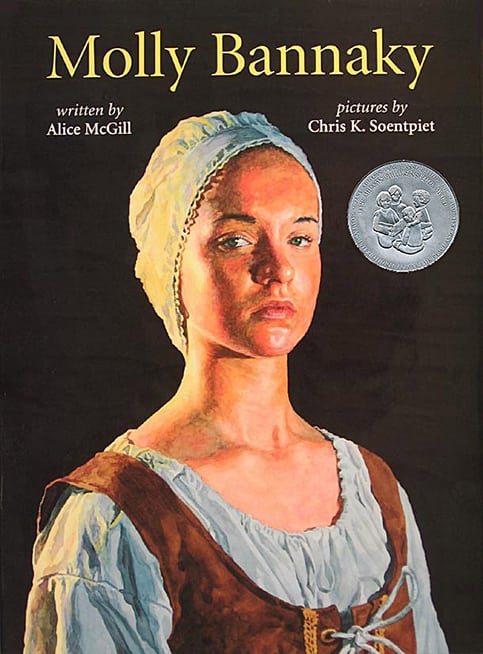 Theme: The book, Molly Bannaky can be used to introduce your students to Benjamin Banneker, Puritan life, Colonial history, farming, slavery, indentured servants, biracial marriages and women in history.
Theme: The book, Molly Bannaky can be used to introduce your students to Benjamin Banneker, Puritan life, Colonial history, farming, slavery, indentured servants, biracial marriages and women in history.
Background: In the late seventeenth century, many people from England chose to leave the hunger and poverty of their country to become servants in the American colonies. In exchange for sea passage, these indentured servants agreed to work for seven years and be exiled from England by law.
After a grueling two-month voyage below the decks of a ship, where crowded and unsanitary conditions often led to disease, these seven-year passengers were sold to owners, who were required to provide them with food, shelter and clothing. At the end of their term, the bonded servants were given all that was needed to start again on their own. Often they moved farther west and staked claims, because new settlers could pay for the land after their first crop was sold. African slaves had no such options. They were treated as property for the duration of their lives.
Growing up in England, Molly Walsh became a dairymaid for a wealthy noble. In 1683, after spilling some milk, she was brought before the court for stealing. Molly escaped death on the gallows by a legal loophole – she could read the Bible. And instead, she was sentenced to seven years of servitude in the American colonies. After finishing her sentence, she started her own tobacco farm with the help of a purchased slave named Bannaker. They fell in love, were married by a traveling priest and built a profitable farm.
At that time, under colonial law, Molly Bannaky could have been forced into slavery for marrying a slave. Although she was never prosecuted for her “crime”, she always feared retribution from disapproving neighbors.
Molly Bannaky was free, so their four daughters were born free. Their eldest daughter, Mary, also married an African slave, named Robert. When Robert became a baptized Christian, the planter who owned him set him free – free to marry, free to own land, free to come and go as he pleased. Having no last name, Robert took his wife’s name – Bannaky. By the time their first son was born the spelling of their name had changed to Banneker.
Taught to read from his grandmother’s cherished Bible, Benjamin Banneker (1731-1806) went on to become a famous scientist and mathematician. He taught himself astronomy and surveying and was appointed to the federal survey commission that planned Washington, D.C.
Among his many accomplishments, Benjamin Banneker is best known for calculating “ephemeredes,” tables that use the locations of the sun, moon, and stars to measure time. From the year 1792 to 1802, he published an almanac – the first ever by a black man – featuring astronomical tables and scientific essays.
Throughout his life, Benjamin Banneker worked hard to disprove the popular belief that blacks were inferior to whites in intelligence. In 1791, he wrote to the Secretary of State Thomas Jefferson concerning the injustice of slavery, enclosing one of his almanacs. Jefferson answered, agreeing with Benjamin Banneker, and sent a copy of the almanac to the Academy of Sciences in Paris.
Pre-reading: Show the students the cover of the Molly Bannaky, read the book’s title and the names of the author and illustrator. Ask the class what they think the book will be about. Next, show the students only the illustrations and ask them again what they think the book will be about.
Reading: As you read the story, show the class the illustrations. Ask students to look closely at the images. What details can they find in the pictures? Have them study Molly’s expressions. Do they change during the story? How do they change? What was Molly feeling when she saw slaves being sold?
Geography: When Molly Walsh was 17 years old, she traveled from England to America. Which ocean did she cross? Show students the route on a globe.
Plan a modern day trip to England with the class. Ask them to estimate how far and how long the trip will take? Have students list what they would bring along. Then compare and contrast their trip with the trip in the book. Molly’s farm was in Maryland, locate this state on a map.
Science: American settlers quickly found tobacco to be a profitable export crop. It was popular in Europe where tobacco-smoking and snuff-taking had become fashionable. In Maryland, Virginia and North Carolina, vast areas were given over to tobacco plantations. Plantation owners imported large numbers of slaves to plant, harvest, dry, pack and transport their crop to market. When prices fell in the middle of the 17th century, some planters turned to producing rice and sugarcane. What types of irrigation and farming methods were used in Colonial America to grow tobacco, rice and sugarcane?
Literature: Read Dear Benjamin Banneker by Andrea Davis Pinkney. Look for other books by Alice McGill and Chris Soentpiet. If you really enjoyed Molly Bannaky write a review and post it on Amazon.com or Barnesandnoble.com so others can enjoy your reading experience.
Bulletin Board: When Molly left England, she used a “sack” for her belongings. Have students list what they would pack in the sack, if they suddenly had to leave home. And remember, they all will have to carry the “sack” on a long journey, so keep things light!
Molly Bannaky Class Project
This video on YouTube was created as a class project by students. It tells the story of Molly Bannaky and is a wonderful example of what can be done using student drawings and narration. Click on the image to open the video in a separate window.


